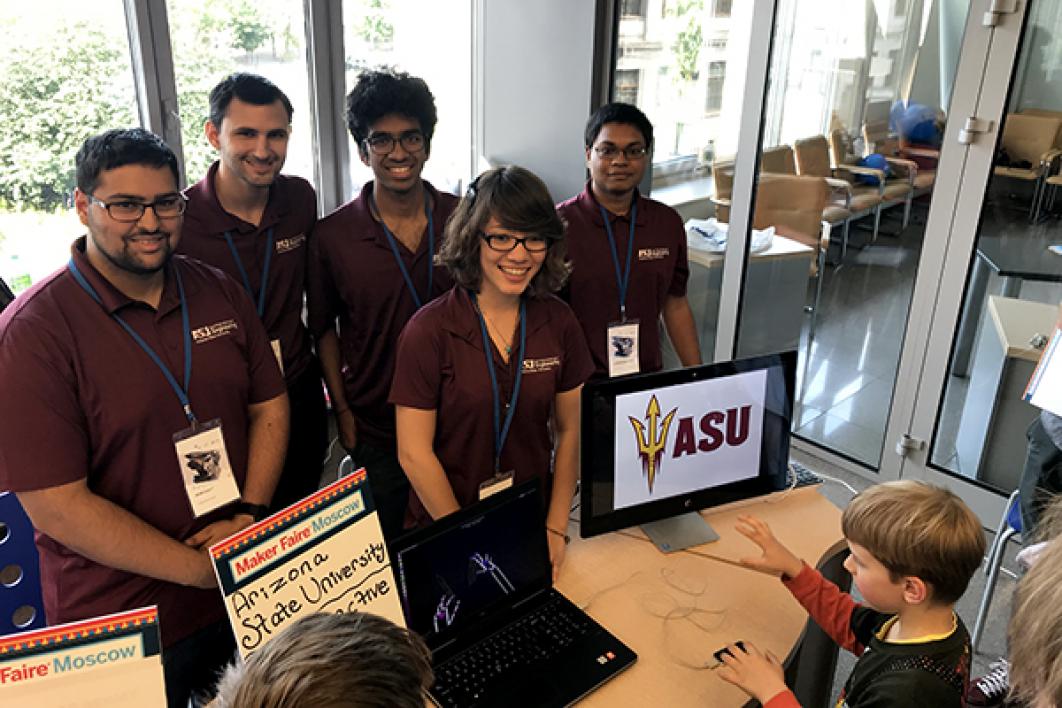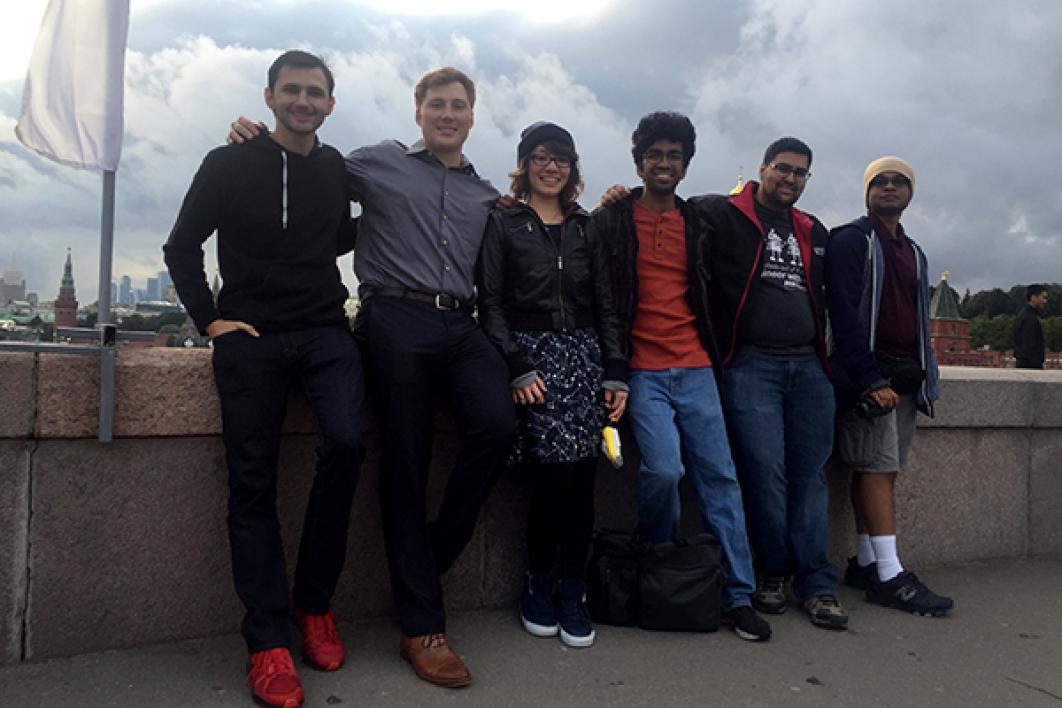ASU hacks the competition in Moscow hackathon

The Arizona State University VisionHack team accepts its award after finishing in first place for Best Presentation, Most Original Approach and Most Innovative in the computer vision hackathon. (From left) Faculty mentor Jared Schoepf, computer science undergraduate students Abhik Chowdhury and Ashley Megumi Satkowski, computer science graduate student Daniel D’Souza, software engineering graduate student Alexander Lampis Slaughter and electrical and computer engineering graduate student and team lead Sami Mian take the stage at the conclusion of the three-day hackathon, held at Moscow's National University of Science and Technology, Sept. 11–13. Photo courtesy of NUST MISIS
Though this story contains the words “Russia” and “hack," an Arizona State University student team's recent trip to Moscow had nothing to do with elections or cybersecurity. Rather, it was the students doing the hacking — bringing home first-place finishes in an international hackathon.
The competition, dubbed VisionHack, was the first computer vision for autonomous vehicles hackathon and tasked 27 teams from around the globe with creating an intellectual subsystem for driver assistance, capable of detecting obstacles and other challenges on the road.
ASU’s solution impressed judges, earning first place for Best Presentation, Most Original Approach and, fittingly, Most Innovative. Dismantling the competition like a stack of Russian nesting dolls, the ASU team finished ahead of the other finalists, which emerged from a field of 242. The hackathon ran Sept. 11–13 at Moscow’s National University of Science and Technology, known as NUST MISIS. The event was organized by the university in partnership with Russian software company Cognitive Technologies.
ASU’s team consisted of electrical and computer engineering graduate student Sami Mian, computer science graduate student Daniel D’Souza, software engineering graduate student Alexander Lampis Slaughter and computer science undergraduate students Abhik Chowdhury and Ashley Megumi Satkowski. Jared Schoepf, Fulton Schools alumnus and recently appointed director of Engineering Projects in Community Service, accompanied the team as faculty mentor.
The ASU team's trip was fully funded and sponsored by NUST MISIS, and ASU was one of three American universities to earn a spot in the competition, along with MIT and University of Wisconsin–Stout. Peking University, the Harbin Institute of Technology and the University of Science and Technology Beijing represented China in the hackathon, and students from the University of Cambridge and Spain’s Polytechnic University of Catalonia supplied the other non-Russian European contingent. Nineteen teams from various universities across Russia also competed in the competition.
A rigorous challenge
Team solutions were scored on six obstacles they were charged with teaching the computer to identify: a bridge, a tunnel, windshield wipers, crosswalks, speed bumps and road signs denoting city exits and entrances.
The key to ASU’s approach was prioritization, according to Mian, who served as the student team lead due to his experience with international competitions previously.
“We had six different types of obstacles to account for, so we looked at the problem overall and tried to determine which obstacles, if any, would overlap,” Mian said. “We then prioritized the challenges based on what we thought was most critical — that being the crosswalk.”
Schoepf, who recently earned his doctorate in chemical engineering from ASU, is no stranger to pitching and presentations. Not only did he co-found the startup SafeSIPP, but he has mentored more than 200 EPICS teams and participated in many of ASU’s entrepreneurship and venture development programs. While faculty members weren’t permitted to help with the technical challenges, they could aid in presentation preparation, which is where Schoepf lent his expertise.
“Jared really helped us consolidate our story and find that thread throughout,” Mian said. “I’m not sure many faculty members could’ve helped us as much as he did, whether it was helping us polish our presentation, motivating us to work or just making sure we took a break and ate every so often.”
As well as presenting to a panel of judges — where the ASU team picked up its first-place finishes — there was a purely technical scoring round as well. The team placed fifteenth overall, but first out of the U.S. universities — soundly defeating MIT and Wisconsin — and completed the challenge first. In addition, they submitted only four of the six criteria for judging in this round.
“We were risk-averse,” Mian said. “We determined we potentially stood to lose more than gain on those two criteria, so erred on the side of caution and opted out.”
The cultural and lingual barriers of the competition were particularly challenging, according to the team. The Russia-centric competition’s provided materials introduced a whole system of unfamiliar traffic laws, signs and patterns. No one on the team spoke or read Russian, let alone had an understanding of the Cyrillic alphabet.
Despite being at a disadvantage, the team worked tirelessly through the three-day event, never leaving the enormous hall where all the teams worked. They took shifts sleeping in bean-bag chairs while other teams returned to their hotels, and their constant presence earned them the nickname “Camp ASU,” according to D’Souza.
Cultural and technical exchange
Though the competition was fierce, getting to know students from other competing universities was a highlight for the entire team.
“I really enjoyed talking to other teams — I learned some things about materials science from the Cambridge team, and about statistics from the Harbin team,” D’Souza said.
In addition to the competition, the team had time for sightseeing and presented at the Moscow Maker Faire, which ran Sept. 9–10. The team set up a human-machine interface demonstration, which D’Souza put together, drawing on his experience working in Professor Subbarao Kambhampati’s lab. The demo displayed the ease of human-machine interaction both online and in person.
The team noted how welcoming and helpful their hosts were. The host university provided cultural presentations and technical lectures from sponsoring companies following the hackathon, as well as student volunteers to serve as guides and translators, taking visitors around the city.
“I really enjoyed exploring different museums around Moscow,” D’Souza said. “It was interesting to see history from another perspective, especially that of the Space Race. I learned some interesting things about that period, such as how the Russians were the first to launch space stations and successfully complete a soft satellite landing on the moon.”
Schoepf was equally enamored with the experience and plans to return.
“It was my first time in Moscow, but it definitely won’t be my last,” Schoepf said. “We had a fantastic experience learning about the Russian culture, the engineering programs at the university and interacting with the students and faculty from the other universities.”
More Science and technology

ASU-led space telescope is ready to fly
The Star Planet Activity Research CubeSat, or SPARCS, a small space telescope that will monitor the flares and sunspot activity…

ASU at the heart of the state's revitalized microelectronics industry
A stronger local economy, more reliable technology, and a future where our computers and devices do the impossible: that’s the…

Breakthrough copper alloy achieves unprecedented high-temperature performance
A team of researchers from Arizona State University, the U.S. Army Research Laboratory, Lehigh University and Louisiana State…




